Man City had one of their most successful campaigns in club history last season, winning the UEFA Champions League for the first time.
As part of a historic treble, it rewarded Pep Guardiola and the team’s hard work over the last 4 years.
In terms of expected points, City had 82, which was a +11.5 difference compared to Arsenal at second place, with 94 goals in the league as the best in top-five leagues; City’s xGA at 33.11 was also the lowest of all teams.
Now all has become history, as this legendary squad will not be the same since crucial players such as İlkay Gündoğan have departed, while Aymeric Laporte, Riyad Mahrez, and Bernardo Silva could also leave.
Ahead of the new Premier League season, we analyze Man City’s tactics and see how they could evolve.
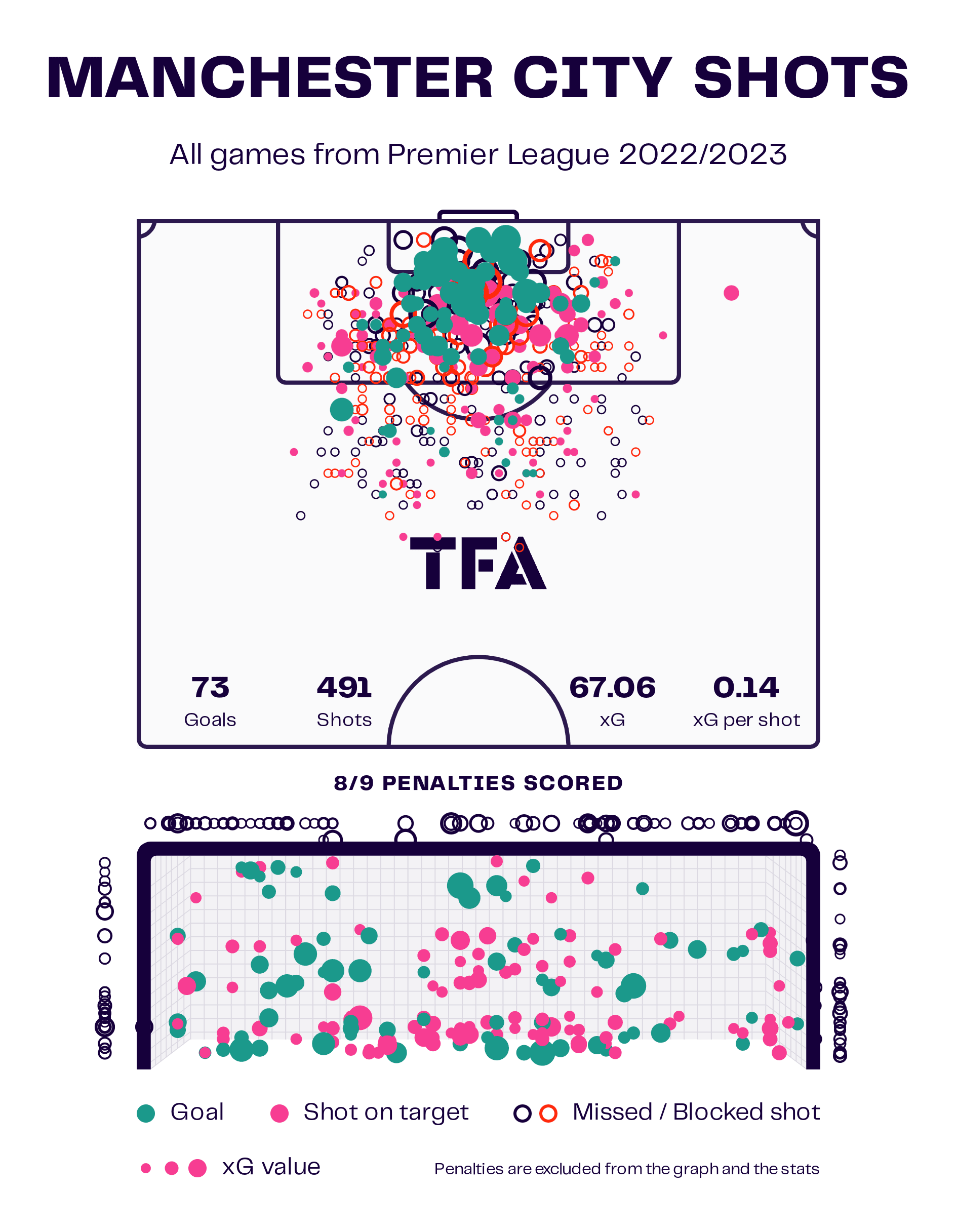
Last season, Man City finally signed the traditional striker they had been missing: Erling Haaland from Borussia Dortmund.
The Norwegian has a significant impact inside the six-yard box, both finding chances and converting them. Because of his physical prowess, he also provides an aerial threat against central defenders.
The viz above also confirms that City were reaching and scoring a lot in the centre of the box.
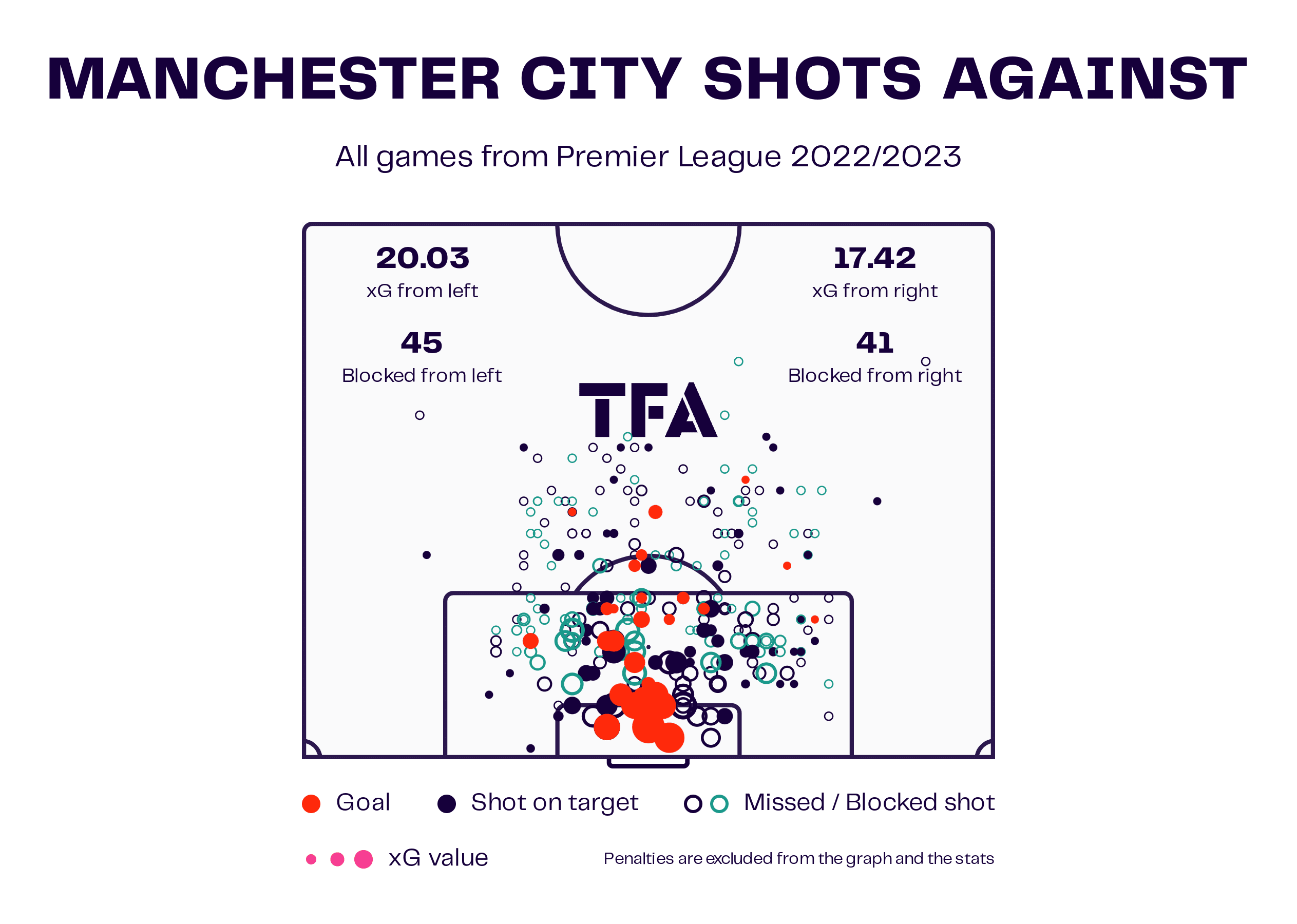
Regarding defensive performance, Man City slightly conceded more chances from the left side at 20.03 than the right side at 17.42.
One explanation could be that they were relatively inconsistent when João Cancelo was still in the team and played as a left-back, while Kyle Walker and John Stones are more solid as a right-back.
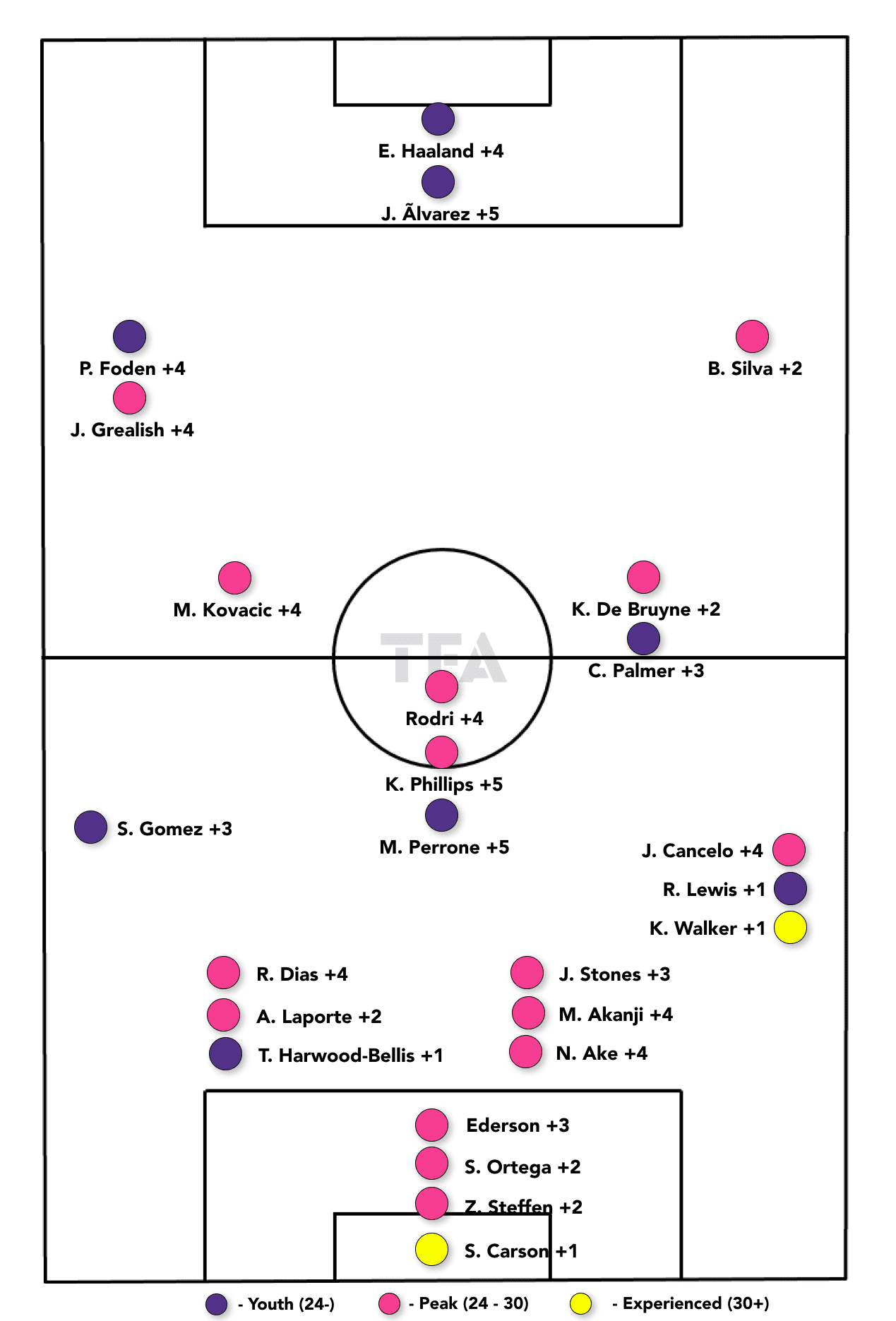
Man City tried to look for different replacements for the squad, as they could have a lot of departures, plus Cole Palmer might leave the team on loan to a club that could help his development, such as Brighton and RB Leipzig.
There are also question marks over Sergio Gómez and whether the club will keep him or look for another player.
So far, the team have only signed one midfielder, Mateo Kovačić from Chelsea.
But they have nothing else after missing out on Declan Rice in the competition with Arsenal.
Many things will depend on the status of current players.
If Walker joins Bayern or Bernardo Silva goes to Paris Saint-Germain, City will be in the market again.
Rumours have circulated about Joško Gvardiol moving to the Etihad, but nothing has been agreed upon with Leipzig yet.
Mateo Kovačić Radar Map
Kovačić is their first new signing.
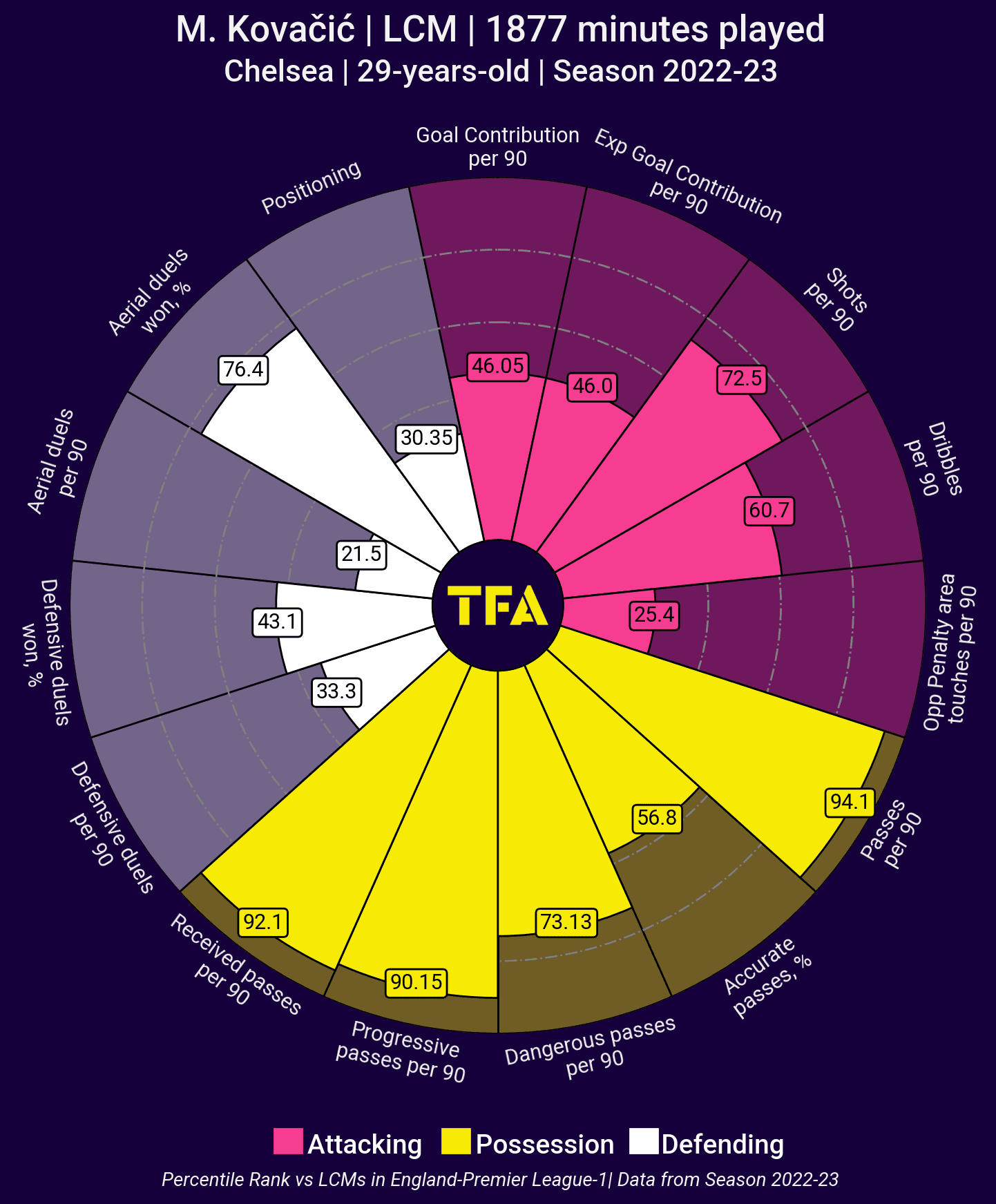
He might not master the defensive metrics, but that would be a matter of the team working together.
In most possession metrics, Kovačić has been impressive.
He boasts a very high percentile ranking at received passes per 90 and progressive passes per 90 (92.1 and 90.15) and is decent at dangerous passes per 90 (73.13).
Although the accurate passes % percentile rank was only 56.8, it is understandable since Kovačić is a player who has aggression and directness to play through the defence.
He is so eager to try and push the team forward there could also be some misplaced passes.
But he will be a great addition that adds dynamic to the current Man City squad.
Manchester City’s Attacking phase
As we know, City struggled in some parts of last season, especially when the squad returned from World Cup, and many players were tired both mentally and physically.
City fought hard to win some games but also had many disappointing defeats, including losing 0-1 to Tottenham, a 1-1 draw at Nottingham Forest, and a 1-1 draw with Everton.
Furthermore, they dropped points in the match with Brentford at home and Aston Villa away before the break.
However, Pep managed to find his optimal solution and stuck with his famous 3-2-2-3 in the last part of the season, and this became a crucial turning point as it allowed the team to attack well and defend well.
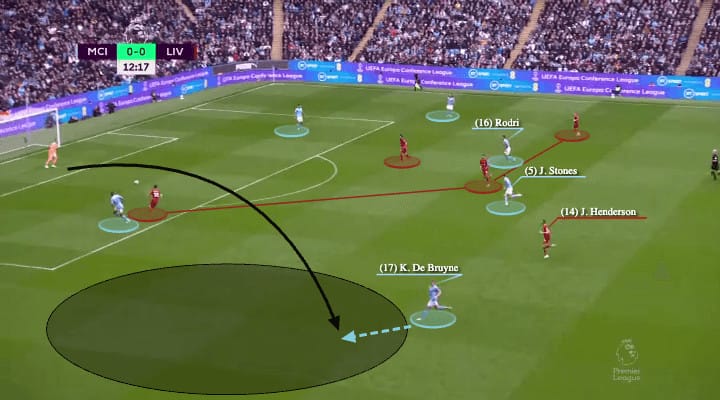
Pep preferred playing with one holding midfielder at the beginning of his coaching career because Sergio Busquets was the best in the world.
You don’t need to give him a partner.
But things have changed a lot in recent years, especially Juanma Lillo’s influence next to him inside the club since 2020.
Pep also occasionally used two holding midfielders to fit both Fernandinho and Rodrigo Hernández.
Now he took a step forward to establish a partner for Rodri in possession.
Sometimes it could be Bernardo, sometimes Rico Lewis, and this role fell to John Stones in the end.
As shown in the above image, Man City played with two holding midfielders close to each other in the build-up phase.
Then the remaining defenders could form a back three.
This allowed the team to create different advantages on the pitch.
Numerically, two midfielders (Stones with Rodri) could overload the opposition 10 in the form of 2v1 in the centre.
The back-three could also invite the opposition winger to jump on them, so they vacated the wide space to allow other players to enter as dynamic supports.
Here, Diogo Jota was pressing Manuel Akanji, so Liverpool’s left-winger was not on the flank but in the centre, which allowed Kevin De Bruyne to take up free space to attack.
Of course, Jordan Henderson could follow him all the way, but this would expose his backline without any protection.
It always became a decisional dilemma for the opponent to decide how to close City down.
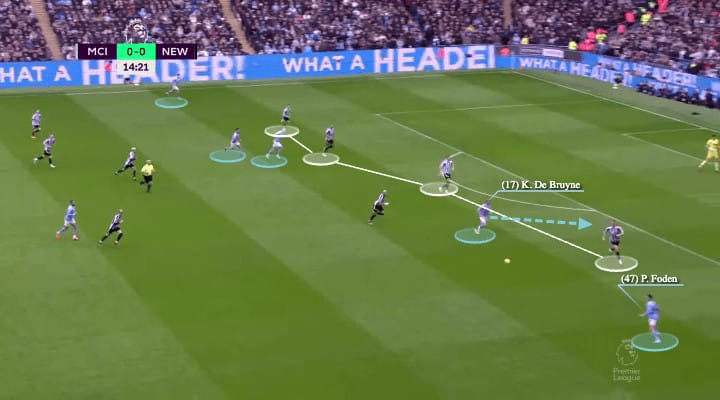
Despite spending a long time searching for an optimal way of playing that suited City’s need during that time, Pep did not lose his core concepts, such as letting the ball run and not the players run, being in their positions and allowing the ball arrives.
One noticeable mark of this kind of football was the disciplined front five, in the forms of 3-2-5 or 2-3-5, players occupying all vertical channels on the pitch.
The above image showed the scene before Phil Foden scored the opener against Newcastle, which structurally benefited from a front five.
As Newcastle played with a back four, they needed help to shuffle quickly enough to cover all channels when City switched the ball suddenly.
De Bruyne’s blindside run in half-space engaged the left-back, opening up more space for Foden to drift in and shoot, but all the space created in the process should be credited to how City maintained the discipline to hold the shape and disorganised the backline with the change of speed.
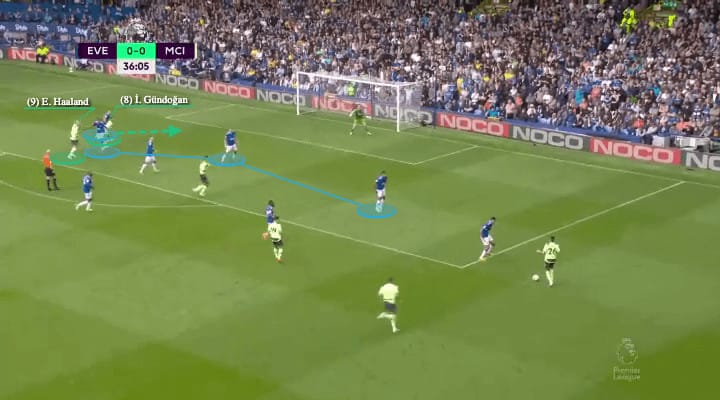
Erling Haaland was definitely the best and most important player to Man City as the Norwegian striker scored a crazy amount of goals in his debut season in England – 36 goals in 35 Premier League games, and 52 goals in 52 matches in all competitions.
In the last part of the season, the opponent also tried to focus more on Haaland, and his scoring rate was not as good as at the start.
But Gündoğan stepped up and proved his scoring ability again when City tried to unlock the low defence.
The German international had an excellent relationship with Haaland, so the two understood each other’s movements well.
It became City’s secret weapon, as they could rely on Gündoğan arriving at key positions when Haaland was marked.
The backheel goal against Everton was fantastic.
However, according to the player himself, it was not an improvisation, but it was also practised in training repeatedly.
It was also interesting when we looked at how the chance was created.
When Riyad Mahrez and Kyle Walker were attacking the right flank, Haaland was marked by central defender Yerry Mina tightly, and he decided to delay the run so as not to kill the space in the move.
Then his position pulled a significant gap in the last line.
Gündoğan was second to none when arriving into situations like this, as he was susceptible to the gaps and could finish his actions well.
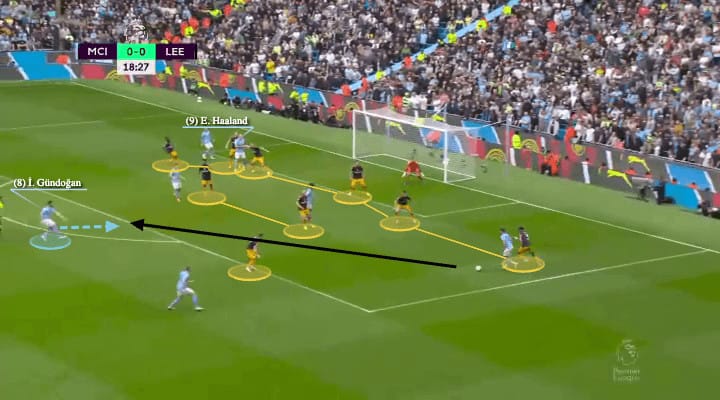
Another point, as Lillo mentioned, is that nowadays, the football trend is that the further away from the goal, the higher the chance of scoring.
Because more teams were willing to sit very deep and even settled to defend in their penalty box for a large part or even put many players to shut down the six-yard box completely.
Sam Allardyce’s Leeds United played like that at the Etihad Stadium; the above image showed Haaland was in the six-yard box, but there were a lot of players around, so it would be difficult to find him.
In these situations, Gündoğan could be a solution outside of the penalty box as the opponent could not cover that area, and again the captain could finish as well.
The second goal was almost a replica of the first one, as Gündoğan caught the same area to shoot.
Now City, without Gündoğan’s great sense of smelling the chances, would they have problems in the final third? This is a part Pep must address next season when Haaland was always attracting markers.
Manchester City’s Defensive phase
Defensively, how Pep set up his team needed to be discussed more when most discussions focused on possession phases.
The Catalan was sophisticated and demanding of his team.
He wanted them to master all stages of plays, even if they did not have a pressing monster like N’Golo Kanté.
City had good numbers in this part of the game, but they have also shown many weaknesses, mainly in UEFA Champions League games where the opponents had the quality to expose them.
This section analyses how they generally pressed and what their underlying concerns could be in preparation for next season.
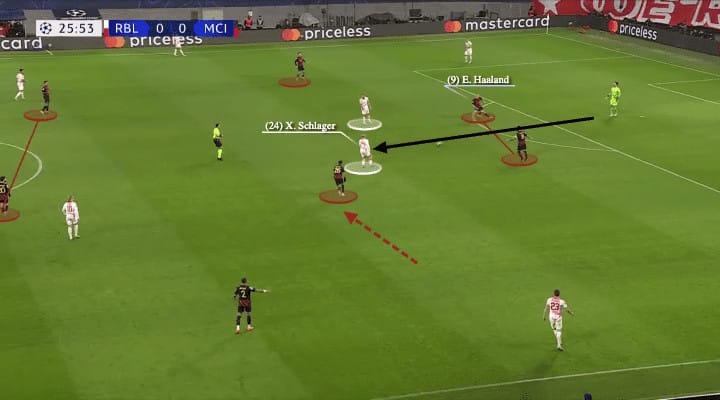
In February, City scored one goal vs RB Leipzig, attributed to high recovery, which was actually with good luck as it was not a good pressing.
City’s setup was almost a 4-2-2-2 when Bernardo stayed deep with Rodri, Gündoğan pushed high with Haaland, and wingers with various roles defensively depending on the tasks.
The problem with City was Haaland’s defensive sense, the timing of his jump, the angle to approach, and the speed he offered were not precisely as Gabriel Jesus before because they were simply different types of players.
So, the opponent could find space behind their first line of pressure and create attacks from there.
In this goal, Haaland needed to get the correct timing to jump on Janis Blaswich.
Then, he was too distant from both Leipzig midfielders, as Xaver Schlager could receive the ball behind him, with Konrad Laimer supporting him very closely as a third man.
Although Mahrez came in, the Algerian needed to be more intense in his defensive action, which could be why Pep preferred Bernardo as a winger in big games afterwards.
It was a goal only because Schlager made a bad pass, but by condition, Leipzig had more space than enough to play out due to Haaland’s ineffective pressure.
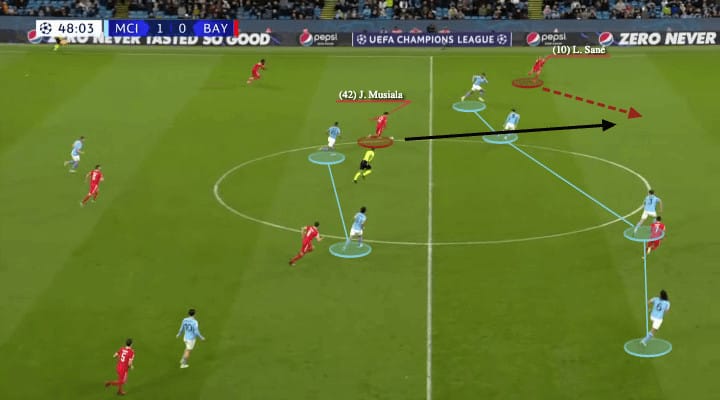
The critical question of Man City was usually how they managed the defensive positions of their midfielders.
If they were too far from Haaland, the opponent could play behind the first line of pressure.
If both of them moved high to support the striker, they left space behind for the opponents to create.
If one of them jumped, the remaining one could be exposed in too big areas to cover, as Gündoğan could not recover before Vinícius Júnior scored the first goal in the UEFA Champions League semi-final.
This was a big problem in the first leg with Bayern.
Although City won the game by a considerable margin, they suffered from ineffective pressing, mainly in the first half, because Jamal Musiala was so good technically to play between the lines and turning in tight spaces.
City were caught at times, and at the beginning of the second half, they allowed Musiala to turn behind Rodri and Gündoğan.
When that happened, City’s last line was somewhat disorganised, allowing Leroy Sané to receive behind.
It could be a decisive and dangerous opportunity for the opponent.
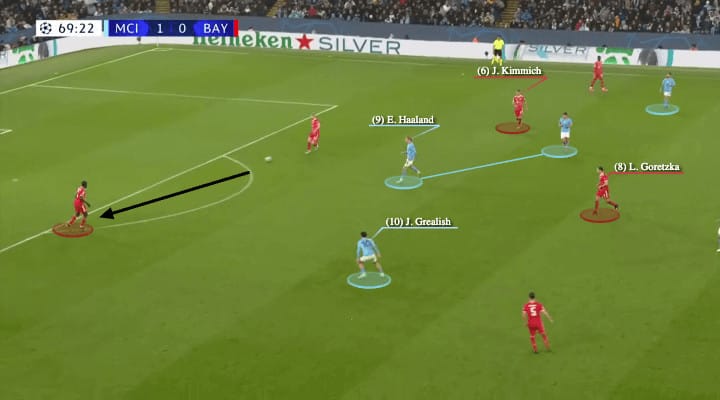
The adjustment of the pressing ways was Pep’s strength last season.
He could start the game with “wrong” pressing ideas based on his analysis before the match and suffered in some moments, but during the game, he changed and helped the team to play better.
It became a decisive turning point in both the UEFA Champions League game against Bayern and the critical battles with Arsenal in the Premier League.
At the start of the Bayern game, City planned to use Haaland to jump on the centre-backs, but that proved ineffective.
They were pretty vulnerable against teams with two holding midfielders, such as Leipzig’s 4-2-3-1 and also Bayern’s Leon Goretzka and Joshua Kimmich.
It became a pain in the ass for Rodri and Gündoğan to decide on holding their positions or pushing to support.
But Pep changed how they pressed in the break, and City scored a vital pressing goal.
In the above image, City were pressing high; Haaland should have jumped according to the initial plan when the ball was going to Dayot Upamecano.
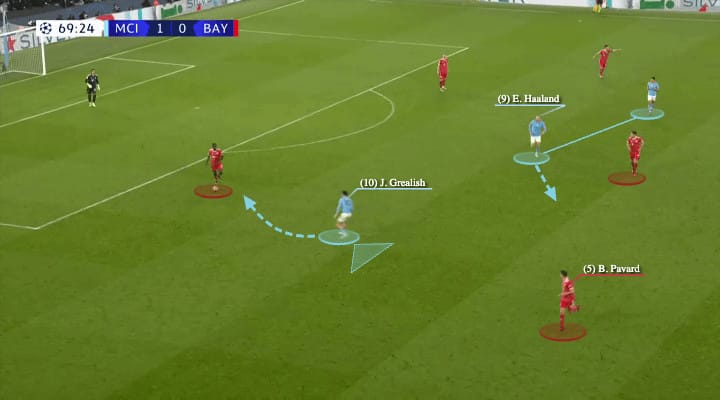
Pep has changed it.
Instead, City pressed with the wingers in the second half, so Grealish jumped and curved his run to cover Benjamin Pavard.
Haaland covered the holding midfielder, not jumping on the central defender.
Then, Upamecano made a mistake, and City got that second goal.
Although they have been successful at pressing with wingers, they still need to address issues when they jump with strikers because the best team in the world did not only defend in one way.
They have to be strong enough to adapt to different opponents.
Could they improve on this part in the 2023/24 campaign, or whether Pep could find another solution to help Haaland in phases without possession? It would also be imperative.
Manchester City’s Transitions phase
During Pep’s Man City tenure, he has tried to deal with transition issues in different ways, as he faced many opponents who were good at this.
Previously, he suffered from Monaco’s fast attacks, the lethal partnership of Heung-min Son and Harry Kane in quick counters, and, of course, Liverpool’s prowess with Sadio Mané, Mohamed Salah, and Roberto Firmino.
But this season, he got some answers on how to address this phase better.
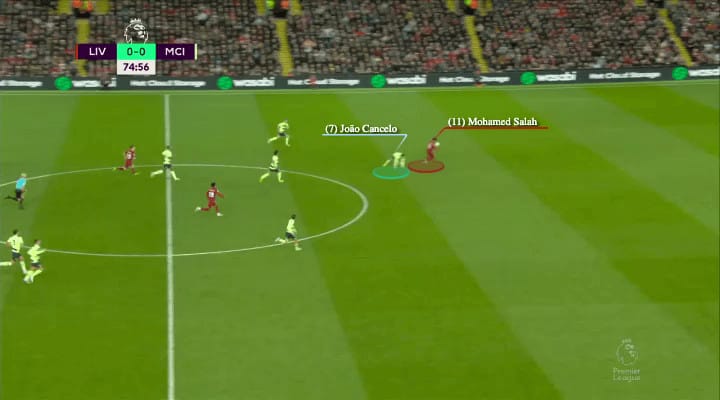
At the beginning of the season, when Pep got many options, he still played João Cancelo as a full-back, but the Portugal defender got it wrongly many times in individual defending.
This was his weakness, and despite all the years, he was still vulnerable and lacked consistency in defending in some moments of the game.
Against Fulham, he received a red card, and against Liverpool, as the above image shows, Cancelo made an utterly wrong challenge on Salah, and it became a 1v1, which Ederson was not particularly good at facing those situations.
Fortunately, Lewis impressed in his playing time, which allowed Pep more room to test different things. He discovered that he could play central defenders at full-back or just push someone next to Rodri.
The primary difference between central defenders and full-backs was their defensive competence.
Akanji, Nathan Aké, and Stones were far more capable of defending in 1v1 and transitions and making fewer mistakes when opponents were running towards the defence.
Then, Pep also had other tools to help him.
This was the luxury function of having Grealish and Bernardo in the team.
The two were extremely good on the ball and could keep it as long as possible, even surrounded by many opponents.
They also had a good judgment of when to play the pass or when to hold or take many touches to allow other players more time to move together on the pitch.
As a result, City could be more organised and prepared in TAD to allow themselves to recover possession easier.
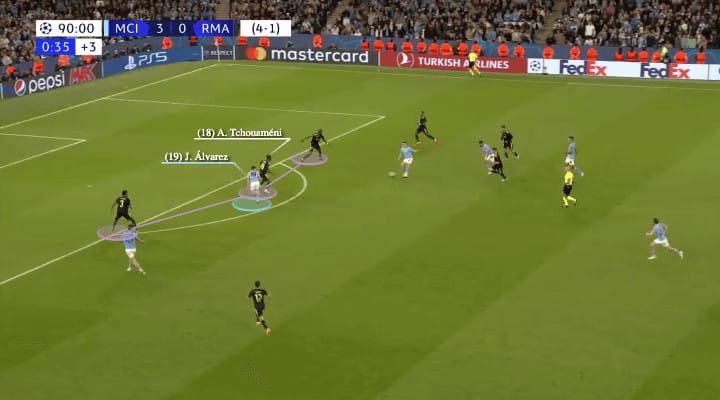
In counter-attacks, City could utilise Haaland’s pace in open space to beat defenders in 1v1 situations.
He finished his Premier League debut against West Ham United and away at Bayern, which was a vital goal.
If the conditions allowed, Pep would expect his team to use the space and attack quickly in transitions, but they don’t have to force it because keeping the ball was also acceptable, as the team could control the game picture with that.
Julian Alvárez would be the most interesting player in this phase of the game as he is direct and can run into opponents.
He contributed significantly to the campaign and helped the team score goals at crucial times.
In the second goal against Bayern, his early run created space for Bernardo’s header, and in the above picture against Real Madrid, he smartly moved behind Aurélien Tchouaméni to make it 4-0.
It also generally concludes that City was good at capturing moments of high turnovers and punishing the opponent in the UEFA Champions League knockout stage last season.
Some of these goals are significant to the flow of the game.
How can City evolve from last season?
It was still early to judge how City could evolve from what they had last season because it depended on many things.
For example, who could see that 3-2-2-3 coming before the previous August, and who could predict the massive fallout of Cancelo?
Sometimes, the situation forced the coach to change instead of deciding everything at the beginning of the season.
But considering the squad now, this team could have other possibilities, especially the backbone players’ dynamics.
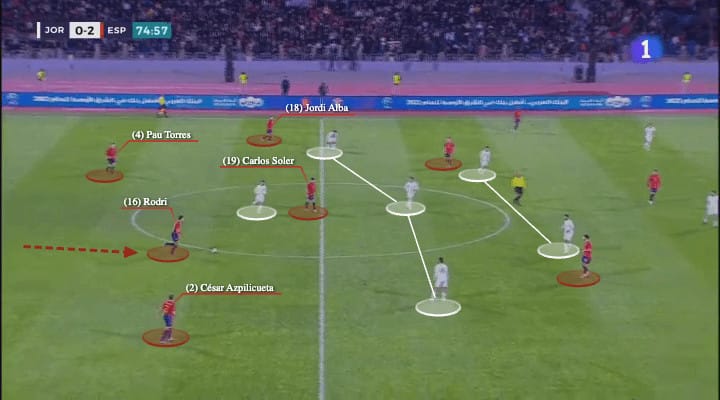
One possible change is the midfield option. City tried to purchase Declan Rice from West Ham, but they could not outbid Arsenal.
But they also had Kalvin Phillips, a solid holding midfielder under Marcelo Bielsa at Leeds.
We usually predicted that the new signings would struggle in their first season under Pep’s City, and Phillips was one of them.
He only had two starts when he was included in 27 Premier League games and played 593 minutes in all competitions.
Could we see Phillips and Rodri playing together? The Spaniard could start as a defender on paper and drive out, as he did in the national team, which would give the team some dynamics and more play possibilities.
Key player: Erling Haaland
Without a doubt, Erling Haaland will continue to be a key player at Man City.
This tactical analysis picked him over De Bruyne as the Belgian international was ageing and had carried some injuries since the end of last season.
He will be missing and rested in some games for sure.
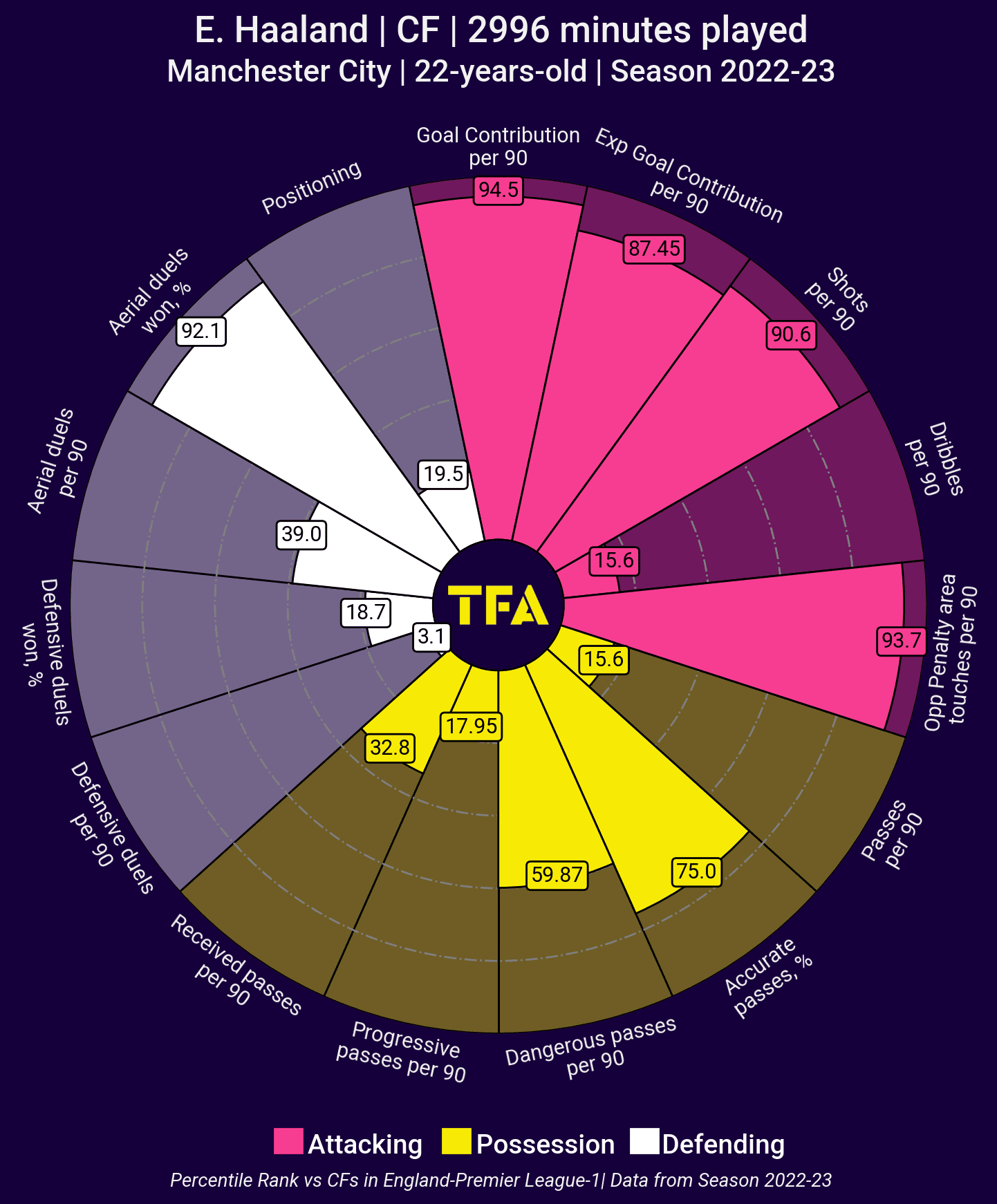
The pizza chart shows how lethal the style of Haaland is.
He has a very low percentile of dribbling (15.6).
Still, in all other percentiles related to threats to goal metrics – opp penalty area touches per 90 (93.7), shots per 90 (90.6), exp goal contribution per 90 (87.45), and goal contribution per 90 (94.5) are above 90.
He is the most dangerous striker on the planet and will be the leading scorer for Man City.
One To Watch – Mateo Kovačić
Man City secured the signing of Chelsea midfielder Mateo Kovačić very early in the window.
The Croatian midfielder was very experienced, and we should not see him as a direct replacement for Gündoğan because both were different players.
We selected him as the “One To Watch” as City usually did not have an explosive midfielder who was good at carrying the ball over large distances, maybe Yaya Touré was the last one, but that was a long time ago.
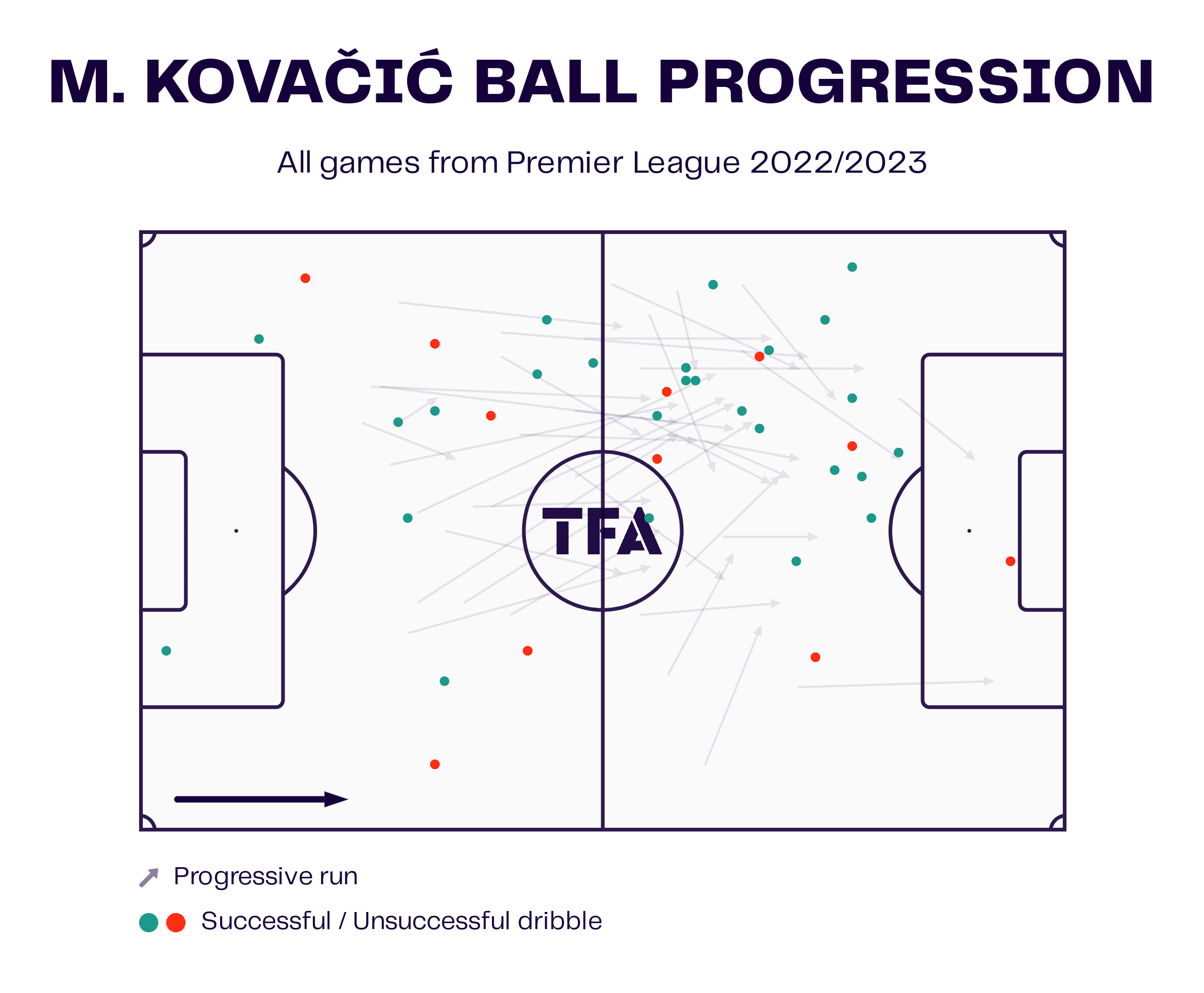
We still don’t know how Pep would use him.
But we can see his strengths as a player with the above viz.
In this level, of course, Kovačić had a decent level in his passing game, but his greatest value that made him unique was the ability to take on opponents in the opposition half and carry the ball forward.
See the excellent spread of his successful dribbles in the attacking half and carries in the above screenshot.
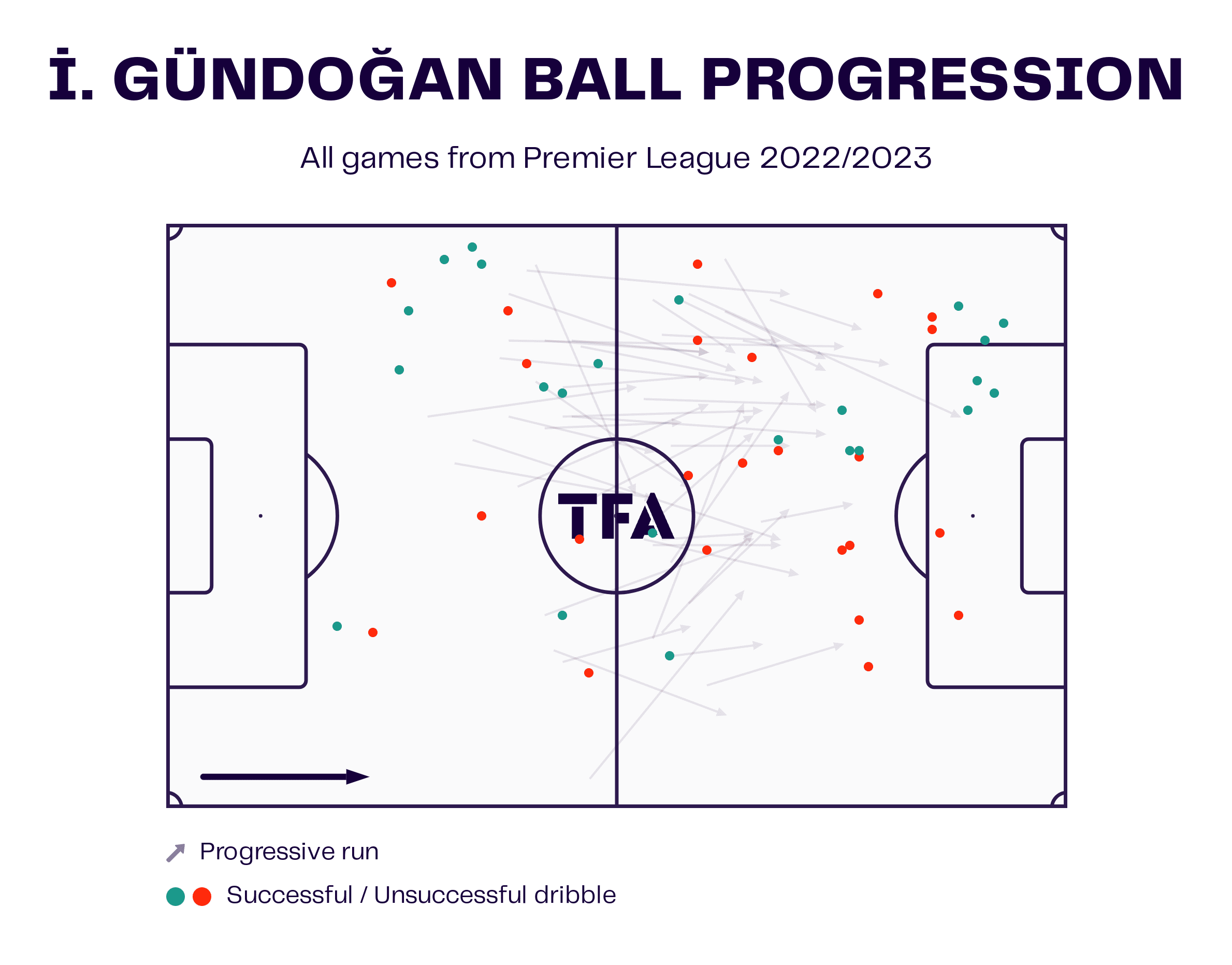
By contrast, Gündoğan was not that kind of player.
The viz above shows his ball progression last season. Although he was able to take on defenders in the box, his dribbling was not as effective elsewhere in the attacking half.
This shows that the two were two different types of players Gündoğan would be better in the box and have a very good tactical sense to organise the team offensively and defensively.
Meanwhile, as the scout report evaluates, Kovačić would offer very different functions to the team, and therefore 3-2-2-3 was just a past.
City must look for solutions that fit their current players to continue building on the excellent work.
TFA Verdict: 1st
No Gundogan and no Mahrez – surely that means others have more of a chance to catch Pep’s winning machine?
Maybe, but probably not – Gundo replacement Kovacic has won the Premier League and the Champions League, and Guardiola is hardly short of exciting comprehensive options to soften the blow of Mahrez going to Saudi.
It’s hard to see anything other than City getting that four-in-a-row on the pitch anyway.

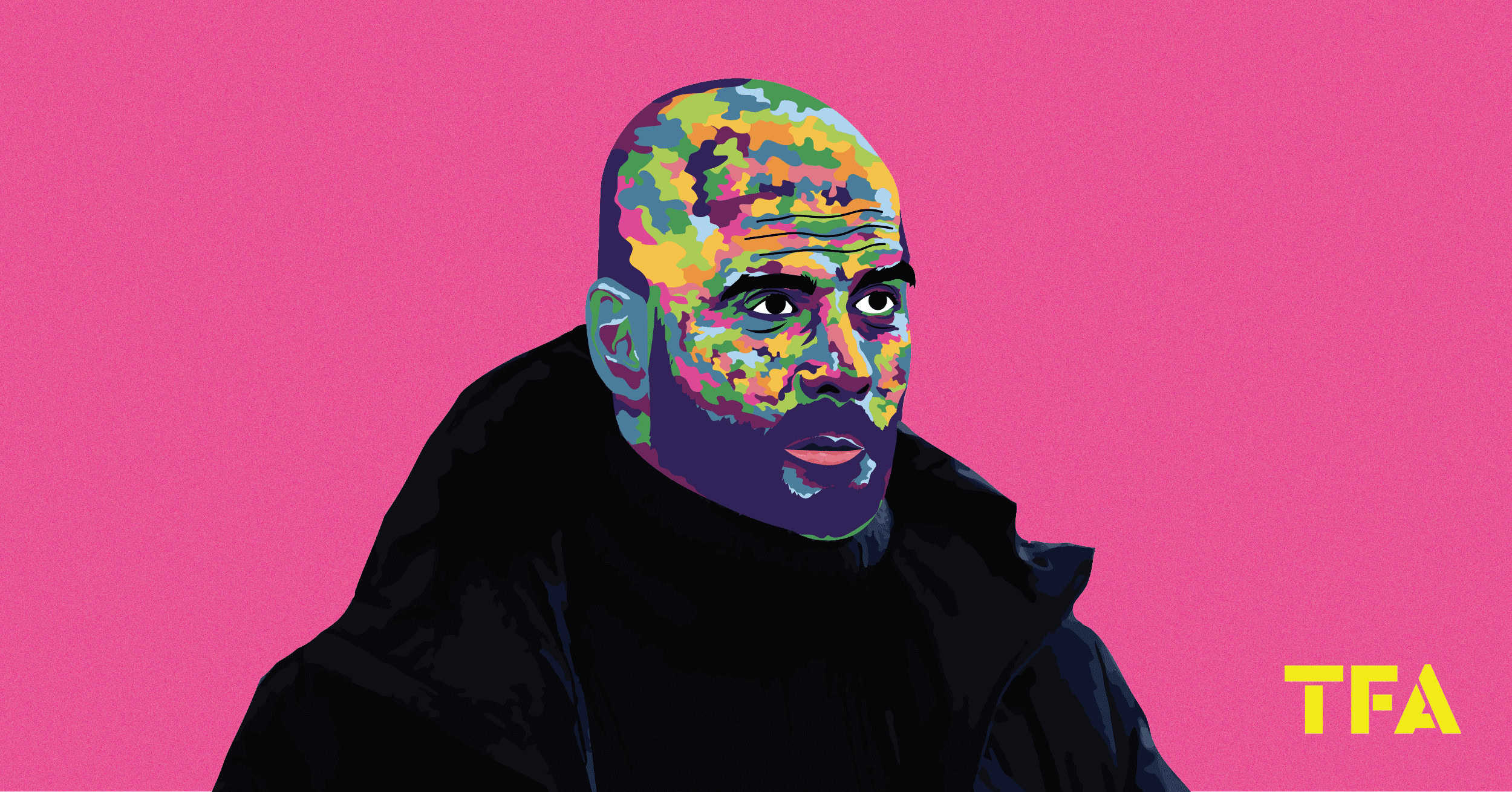



Comments